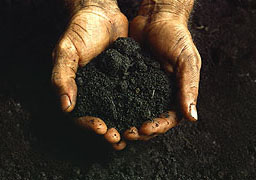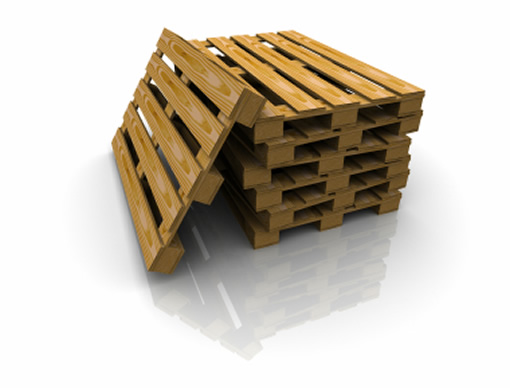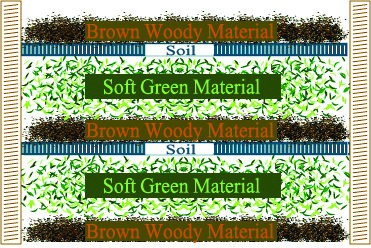
WHETHER IT BE VEGGIES, flowers, fruits, or forests: more and more gardeners these days are turning to the benefits of organic growing by means of compost. Produce just seems to taste better when grown this way, yields are larger, and swaths of earth are spared the nutrient stripping affects of chemical fertilization. And the real kicker … not only can you can make the stuff yourself; outside of a little bit of work and an initial setup-cost, it’s absolutely free to do so.
What’s A Compost Pile?
A compost pile is an eco system on to itself that’s home to millions of billions of micro-organisms called soil bacteria which, if conditions are good, live, dine, and thrive on the organic matter we humans consider waste. It’s these bacteria who are the real workhorses in the composting process. You as the pile maker and keeper are simply in the equation to see that their environment has the right amount of food, water, and air circulation.
How Does It Work?
When it comes down to it we, as gardeners, are really looking to get manure from our compost piles. To understand how a compost pile works you must first understand just what kind of numbers
One single teaspoon of dirt (not compost), for example, contains more of these micro-organisms than the entire Earth contains people. That’s somewhere in the vicinity of 6.5 billion, and that’s in a teaspoon of non-food-rich soil. As with the people peppered on the planet, the bacteria population swells as food becomes more plentiful (ie: in your compost pile). One thing leads to another, your pile becomes home, then dinner, then manure, then fertilizer on your garden, then dinner on your plate, and so on, and so on, and eventually you come to realize that you’re not only watching the wheel of life in motion, you’re part of it.
How Do I Get Started?
Before you do anything else, pick a location for your pile. Things you should consider when doing this include appearance, and easy access. Since a compost pile, most likely, isn’t going to be the most attractive addition you’ve ever put in your yard, you’re going to want to locate it in an obscure location—away from plain sight. On the same note, you don’t want to put it so far away from your house that taking food-scraps to it becomes more of a chore than it has to be. Smell and critter attraction do not need to be considered. A properly maintained compost pile with the correct ingredients won’t stink, and therefore won’t attract unwanted guests.
Once you have an idea of where you want your pile, you’ll need to set up corrals. I’m going to be explaining the three-bin-system here, but I suggest surfing YouTube before committing to any one method. Type in phrases like, How To Make Compost Bins, How To Make A Compost Pile and, Vermicomposting (composting with worms). There are many different ways to compost, and choosing one over the others shouldn’t be done without at least first exploring your options.
Building your corrals can be as cheep or easy as you want it to be. My explanation is going to utilize recycled pallets, but you can go as simple as staking of an area and fencing it in with chicken-wire, you can use store-bought lumber if you want a more attractive set of corrals, or you can even buy a ready-made system from your local garden center.
Some composers chose to put bottoms in their corrals. This is acceptable but keep in mind the desired end result is to have your raw material transformed into manure. By putting a floor between the bare ground and the compost pile you’re prohibiting worms and other creepy crawlies from gaining access via the underside of the pile. Poop is poop after all, and at the end of the day the fewer eaters you have in there, the slower the breaking-down process is going to take.
Assuming you’ve chosen to not put bottoms in, you’re going to need a total of seven pallets. If you do desire bottoms an additional three will be needed. Most pallets have semi-large spaces between their slats which, if not remedied, will allow your composted material to fall through. To fix this problem you should cover the insides of your corrals with wire mesh. Alternatively, if you prefer, you can fill these spaces with ripped wooden slats. If this solution is your preference, be sure leave some gap; airflow is essential to the composting process. Also, do NOT use treated lumber. A: your micro-organisms will not be happy with you, and B: it’s poison; you don’t want it leaching into your product.
To fix this problem you should cover the insides of your corrals with wire mesh. Alternatively, if you prefer, you can fill these spaces with ripped wooden slats. If this solution is your preference, be sure leave some gap; airflow is essential to the composting process. Also, do NOT use treated lumber. A: your micro-organisms will not be happy with you, and B: it’s poison; you don’t want it leaching into your product.
On ground that is more or less level, take three of your pallets and place them in a U shape. The opened end of this will be the side where you’ll be loading, mixing, and unloading, so have it facing in the direction you’ve decided you want to be doing this from. This is your center corral. Fasten the corners together with either screws, wire-ties, or a heavier twine. Keep in mind there’s only going to be rotting plant matter in there; it doesn’t have to be pretty unless you want it to be pretty. If you do want it to be pretty I suggest not using pallets.
To either side of your U, now, take two more of your pallets and form an adjacent U—only this time the side of your center corral will be used as one of your sides. Its mouth should be facing in the same direction, and it gets fastened together in the same manner. Once done with this side, move to the other side of your center corral and repeat this step.
Finally, take a board, lay it edge-down on the dirt along the front of your corrals, and fasten it with screws to each of the four pallets. Take a second board and screw this one across the top of your pallets a foot or two from the front. The dimensions of these boards don’t really matter as long as you can get a screw through them. Their purpose of these boards is to tie your corrals together and make the whole unit more stable.
What Do I Put In My Compost Pile
A compost pile needs to be layered for it to work properly: a layer of brown woody materials to add carbon, covered with a thin layer of soil to add bacteria, covered with a layer of softer green materials to add nitrogen, covered with another thin layer of soil, and back to the brown woody materials again. Repeat this process until the pile fills your first bin. It doesn’t have to be filled to the top all at once. Composting will start to occur after the first layer’s in, and it will move up through the pile as it grows—although it should be noted that your pile will work best when it reaches a height of about three feet. As for how much of each, brown and green materials: make your soft green layers slightly thicker than your brown woody ones. You’ll get better feel for this the more you compost. If you want a more nitrogen rich finished product, add more greens as you build your pile; if you are looking for a more carbon rich soil, add more woody browns.

Enough water should be added between the layers as you build to make the pile moist but not soaking wet. If your pile gets too wet it will start to smell. To fix this add more woody material.
About once a week mix your pile with a pitch fork. This will allow air to reach the center and will speed up the breaking down process. When you start seeing a noticeable difference in the appearance of your compost (when it starts looking like it’s turning to soil), move it into your next bin, and start refilling the first bin. Keep mixing both of these piles about once a week. When the first pile looks as though it’s starting to break down again, move both the first and second piles over to their perspective next bins, and again, fill the first bin. It should take about two to three months to get your first batch of compost, but since you’re working three piles at once, each consecutive batch after that will be ready monthly.
Greens & Browns
Green materials can be such things as grass clippings, fruit and vegetable peelings from your kitchen, and plant matter from your garden, while brown woody materials include straw, leaves twigs, and untreated cardboard and paper. Never put oily foods or meet leftovers in your pile. These will attract unwanted visitors to your pile.
One Final Word
Compost happens. It’s the natural course of decomposition, and it’ll take place weather you choose to take advantage of it or not. Don’t fool yourself into thinking you can’t do it. The fact of the matter: it would be harder for you to stop this process than it would be to oversee it.











